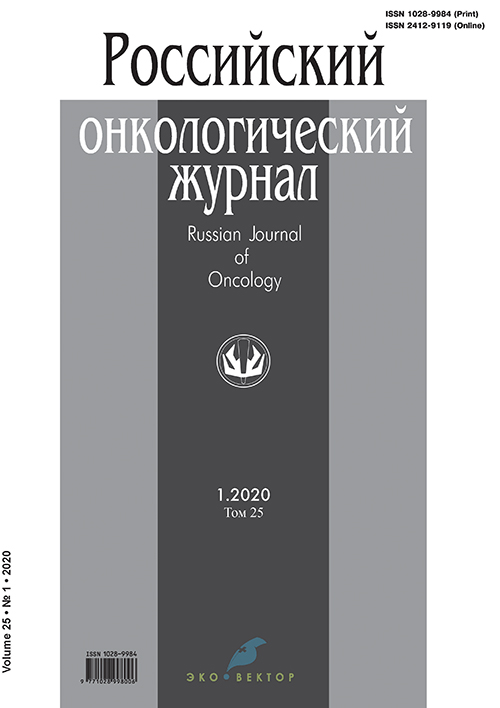Treatment of relapses of gestational trophoblastic neoplasias
- Authors: Meshcheryakova L.A.1, Zharova A.S.1, Maslennikov A.F.1, Kuznetsov V.V.1, Chekalova M.A.1, Komarov I.G.1, Davydova I.Y.1, Molchanov G.V.1, Gigolaeva N.M.1, Meshcheryakov A.A.1
-
Affiliations:
- N.N. Blokhin Russian Cancer Research Center
- Issue: Vol 25, No 1 (2020)
- Pages: 9-16
- Section: Clinical investigations
- Submitted: 08.07.2020
- Accepted: 08.07.2020
- Published: 09.07.2020
- URL: https://rjonco.com/1028-9984/article/view/35004
- DOI: https://doi.org/10.18821/1028-9984-2020-25-1-9-16
- ID: 35004
Cite item
Abstract
The purpose of the study: to present an experience of the N. N. Blokhin Russian Cancer Research Center in the treatment of relapses of gestational trophoblastic neoplasias (GTN).
Materials and methods. We performed a retrospective analysis of medical case histories at the N. N. Blokhin Russian Cancer Research Center from 1996 until 2019. 545 patients with GTN were treated. Relapses occurred in 25 (4.6%) patients: 8 (2.1%) patients with low risk of resistance (6 (75%) – early relapses and 2 (25%) – late relapses) and 17 (10%) patients with high risk of resistance (11 (65%) – early relapses and 6 (35%) – late relapses). Treatment of relapses was done by standard chemotherapy regimens (Dactinomycin 500mcg in days 1–5, EMA-CO, EMA-EP). Different surgical interventions and radiosurgery were used in some cases additionally.
Results. Out of 6 patients with early relapses of low-risk GTN, 5 were cured with chemotherapy and one patient by lung resection only. Two patients with late relapses of low-risk GTN were cured with chemotherapy (EMA-CO) and hysterectomy/resection of uterus to achieve complete remission. As a result, all patients with relapses of low-risk GTN were cured, mainly (88%) by chemotherapy. Among 11 patients with early relapses of high-risk GTN, complete remission was achieved in 6 (55%) cases: in 2 patients as a result of EMA-EP chemotherapy, other patients needed combined approaches (chemotherapy + surgery). Three patients with recurrent course continue treatment, two patients died of progression. Of the 6 patients with late relapses of high-risk GTN, 4 (66%) patients were managed mainly through combined treatment (surgery + chemotherapy) and were cured. One patient continues treatment for more than 4 years, and one patient died of progression. In total, out of 17 patients with high-risk relapses, complete remission was achieved in 10 (59%) as a result of combined treatment in the majority of cases (80%).
Conclusion. The optimal method of treatment for patients with relapses of low-risk GTN is chemotherapy; and for high-risk GTN – combined approaches (chemotherapy + surgery)
Full Text
About the authors
L. A. Meshcheryakova
N.N. Blokhin Russian Cancer Research Center
Author for correspondence.
Email: 2010am@mail.ru
ORCID iD: 0000-0001-8479-3615
Russian Federation, 115478, Moscow
A. S. Zharova
N.N. Blokhin Russian Cancer Research Center
Email: 2010am@mail.ru
ORCID iD: 0000-0001-8591-3797
Russian Federation, 115478, Moscow
A. F. Maslennikov
N.N. Blokhin Russian Cancer Research Center
Email: 2010am@mail.ru
ORCID iD: 0000-0003-3959-3133
Russian Federation, 115478, Moscow
V. V. Kuznetsov
N.N. Blokhin Russian Cancer Research Center
Email: 2010am@mail.ru
Russian Federation, 115478, Moscow
M. A. Chekalova
N.N. Blokhin Russian Cancer Research Center
Email: 2010am@mail.ru
Russian Federation, 115478, Moscow
I. G. Komarov
N.N. Blokhin Russian Cancer Research Center
Email: 2010am@mail.ru
Russian Federation, 115478, Moscow
I. Yu. Davydova
N.N. Blokhin Russian Cancer Research Center
Email: 2010am@mail.ru
Russian Federation, 115478, Moscow
G. V. Molchanov
N.N. Blokhin Russian Cancer Research Center
Email: 2010am@mail.ru
Russian Federation, 115478, Moscow
N. M. Gigolaeva
N.N. Blokhin Russian Cancer Research Center
Email: 2010am@mail.ru
Russian Federation, 115478, Moscow
A. A. Meshcheryakov
N.N. Blokhin Russian Cancer Research Center
Email: 2010am@mail.ru
Russian Federation, 115478, Moscow
References
- Wang J., Short D., Sebire N. J. Salvage chemotherapy of relapsed or high-risk gestational trophoblastic neoplasia (GTN) with paclitaxel/cisplatin alternating with paclitaxel/etoposide (TP/TE). Ann. Oncol. 2008; 19 (9): 1578–83. doi: 10.1093/annonc/mdn181.
- Seckl M.J., Sebire N.J., Fisher R.A., Golfier F., Massuger L., Sessa C. Gestational trophoblastic disease: ESMO clinical practice: guidelines for diagnosis, treatment and follow-up. Ann. Oncol. 2013; 24 (Suppl 6): vi39–vi50.
- Shih I.M. Gestational trophoblastic neoplasia – pathogenesis and potential therapeutic targets. Lancet Oncol. 2007; 8 (7): 642–50.
- Meshcheryakova L.A., Kozachenko V.P., Kuznetsov V.V. Trophoblastic disease. Clinical Oncogynecology: A Guide for Physicians. 2nd. Moscow: Binom; 2016. (In Russian)
- Meshcheryakova L. A. Trophoblastic disease. Tumors of the female reproductive system. 2014; 4: 74–86. (In Russian)
- Mutch D.G., Soper J.T., Babcock C.J. Recurrent gestational trophoblastic disease. Experience of the Southeastern Regional Trophoblastic Disease Center. Cancer. 1990; 66: 978–82.
- Newlands E.S., Bagshawe K.D., Begent R.H. Results with the EMA/CO (etoposide, methotrexate,actinomycin D, cyclophosphamide,vincristine) regimen in high risk gestational trophoblastic tumours, 1979 to 1989. Br. J. Obstet. Gynaecol. 1991; 98: 550–7.
- Soper J.T. Surgical therapy for gestational trophoblastic disease. J. Reprod. Med. 1994; 39: 168–74.
- Goldstein D.P., Berkowitz R.S. Prophylactic chemotherapy of complete molar pregnancy. Semin. Oncol. 1995; 22: 157–60.
- Ngan H.Y., Tam K.F., Lam K.W., Chan K.K. Relapsed gestational trophoblastic neoplasia: a 20-year experience. J. Reprod. Med. 2006; 51 (10): 829–34.
- Wong L.C., Choo Y.C., Ma H.K. Hepatic metastases in gestational trophoblastic disease. Obstet. Gynecol. 1986; 67: 107–11.
- Horowitz N.S., Goldstein D.P., Berkowitz R.S. Placental site trophoblastic tumors and epithelioid trophoblastic tumors: Biology, natural history, and treatment modalities. Gynecol. Oncol. 2017; 144: 208–14.
- Lurain J.R., Singh D.K., Schink J.C. Primary treatment of metastatic high-risk gestational trophoblastic neoplasia with EMA-CO chemotherapy. J. Reprod. Med. 2006; 51: 767–72.
Supplementary files







